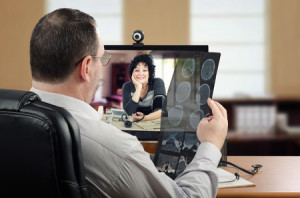The rise of telemedicine
The thought of visiting with a doctor in a video conference seemed like a thing of the future a few years ago. But since the COVID-19 pandemic, telemedicine has experienced meteoric growth. It’s become a way for physicians to deliver health care in a time when Americans nationwide are being encouraged to remain socially distant to curb the spread of COVID-19.

But telehealth isn’t just linked to the pandemic. Telemedicine had been gradually growing in popularity well before the coronavirus outbreak. Nearly all large employers are now offering virtual doctor visits as part of their employee health coverage, up from only 7 percent in 2012, according to the Business Group on Health. About half of all U.S. hospitals provide access to some form of telemedicine.
COVID-19 aside, here’s what’s behind the rise of telemedicine and why people love the technology:
Convenience: We’re all busy. Between work, errands, social life and family responsibilities, it can sometimes seem impossible to fit a doctor’s appointment in. One recent survey showed that 80 percent of Americans prefer telemedicine to a traditional in-office encounter with a physician in many situations, citing that they can get an appointment via virtual visit in a more timely manner than a traditional office visit and they can learn about treatment options in minutes.
With a virtual visit, people don’t have to miss work or leave home, cutting down on travel time. Even better, during the cold and flu season, you don’t have to be around other potentially sick people. Many doctors like telemedicine because it can expand their patient reach and offer an easy way to handle treatment or care discussions. Not all visits are ideal for telemedicine, of course, but many are. Overall, telehealth is more convenient for doctors and patients.
Reduced costs. Did you know telehealth visits can save you money? The national median cost for a video-based virtual visit is $50, compared to $85 for a non-emergency/routine visit at a doctor’s office, $130 for an urgent care facility visit and $740 for an emergency room visit, according to UnitedHealthcare. Telemedicine is often a more affordable option for patients than traditional healthcare. Insurance companies like it because it can cut down on unnecessary ER visits and transportation.
Expanded behavioral health services. Many places in the US have long wait times to see specialists, especially mental and behavioral health services. However, telehealth services mean you can see a doctor in another city or state. It also means the doctors in your area can see more patients.
This is especially helpful for people in rural areas, which often live miles away from service providers. By logging on to your computer, you can connect with doctors faster.
Younger generations really like it. If you know teenagers, you probably know they’re always tied to their phones. Young people – and older generations alike – are more used to having technology at hand. We use our phones for almost everything not- ordering meals, online shopping, even connecting with friends and family. This means that people, especially younger generations, like connecting with their doctors virtually, too.
Millennials, for example, are about 20 percent more likely to use telemedicine than other age groups. Surveys show all age groups are open to telemedicine. Seniors, once they have adapted to the technology involved, enjoy the convenience, studies show.
Overall, we think telehealth is here to stay. It offers tons of flexibility, convenience and lets you access more services than ever before. While not all appointments can be virtual, so many of your basic appointments can. Anything from mental health services, to acute illnesses to consultations can be performed at the comfort of your own home. Do you like using telehealth services?






